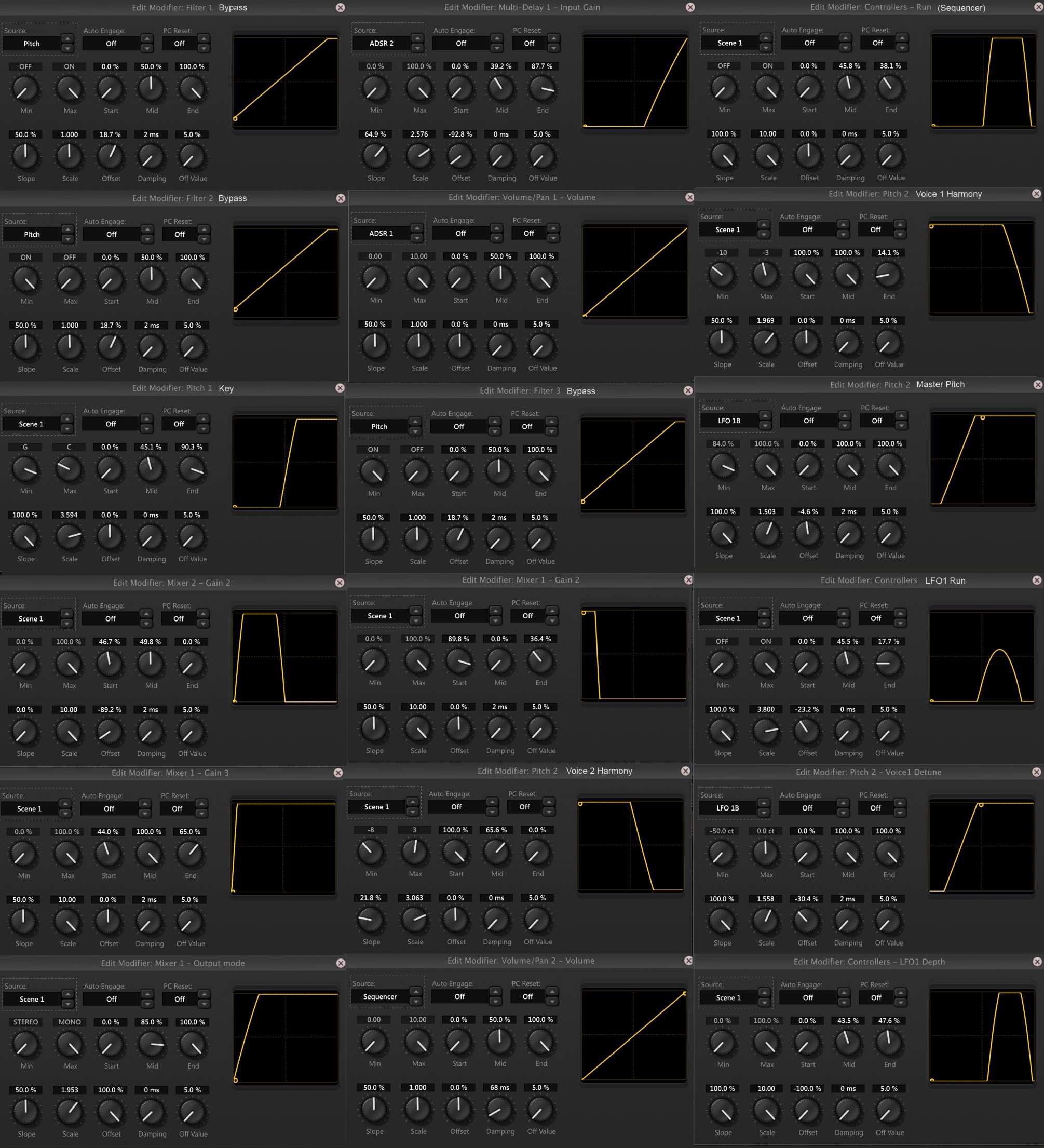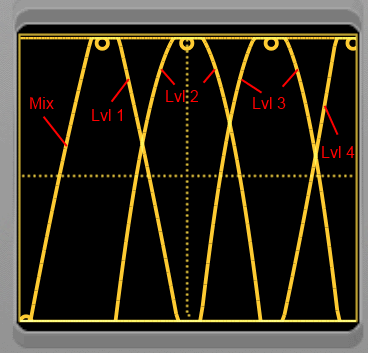1. Hotel California - Verse 2
Generate 5 harmony parts with one guitar. Video/audio demo: https://forum.fractalaudio.com/threads/hotel-california-verse-2.135713/
Global scales
Four global scales need to be configured. If you want to use scales other than 1/2/3/4, Voice 1 Scale & Voice 2 Scale parameters will have to be adjusted in Pitch 1 X & Y states.
ADSRs
ADSR 1 & 2 thresholds should be low enough to trigger consistently on beat 1 of measures 9-15. If they're set too low, the first note of measure 9 may not always trigger properly. Check for that and adjust as needed, using the same threshold value for both ADSRs. ADSR response can be tested by watching Vol/Pan 1's volume parameter on front panel.
Vibrato
Bending certain notes more than 50 cents will make harmonies jump to wrong notes. Reduce vibrato width if this happens, or try a floating bridge for vibrato above/below resting pitch. Make vib. rate 8th triplet (3 cycles/beat) or so for smoothest transition to MTD trail in scenes 3-6.
Tempo
Preset is saved at original song's tempo, 74 BPM. Sequencer and delay used in scenes 5 & 6 are tempo-based. Tap the tempo somewhere earlier for best sync if playing without a recording/click.
Scene changes
A scene increment switch is ideal. Follow the chart here (play only full-size notes) for scene changes:
https://i.imgur.com/TDvK4mx.png
Scene 3 should be triggered slightly after the beat to avoid sending a short blip to MTD. Aim to be a 16th note late. Anywhere from a few ms to an 8th note is fine.
Scene 4 can be triggered anytime before playing the higher G# in the measure. (Scene 3 also gives the correct harmony on the low G#, and there's no glitch when changing.)
Scenes 5, 6, 7 should be triggered exactly on the beat. Scene 8 can be on the beat or slightly early if preferred while sliding out of previous note. Scenes 5 & 6 depend on the sequencer beginning in Scene 5, so if you stop playing while testing it may be out of sync when resuming. (Go back to scene 4 and play into scene 5 for proper results.)

Generate 5 harmony parts with one guitar. Video/audio demo: https://forum.fractalaudio.com/threads/hotel-california-verse-2.135713/
Global scales
Four global scales need to be configured. If you want to use scales other than 1/2/3/4, Voice 1 Scale & Voice 2 Scale parameters will have to be adjusted in Pitch 1 X & Y states.
Code:
GS# 1 2 3 4
A 4 4 -4 -5
A# 3 3 -4 -4
B 3 3 -4 -5
C 3 5 -4 -3
C# 4 5 -4 -3
D 4 5 -5 -3
D# 3 -3 -5 -7
E 3 -3 -5 -7
F 3 -4 -5 -7
F# 3 -4 -3 -7
G 4 -4 -3 -7
G# 3 3 -4 -4ADSRs
ADSR 1 & 2 thresholds should be low enough to trigger consistently on beat 1 of measures 9-15. If they're set too low, the first note of measure 9 may not always trigger properly. Check for that and adjust as needed, using the same threshold value for both ADSRs. ADSR response can be tested by watching Vol/Pan 1's volume parameter on front panel.
Vibrato
Bending certain notes more than 50 cents will make harmonies jump to wrong notes. Reduce vibrato width if this happens, or try a floating bridge for vibrato above/below resting pitch. Make vib. rate 8th triplet (3 cycles/beat) or so for smoothest transition to MTD trail in scenes 3-6.
Tempo
Preset is saved at original song's tempo, 74 BPM. Sequencer and delay used in scenes 5 & 6 are tempo-based. Tap the tempo somewhere earlier for best sync if playing without a recording/click.
Scene changes
A scene increment switch is ideal. Follow the chart here (play only full-size notes) for scene changes:
https://i.imgur.com/TDvK4mx.png
Scene 3 should be triggered slightly after the beat to avoid sending a short blip to MTD. Aim to be a 16th note late. Anywhere from a few ms to an 8th note is fine.
Scene 4 can be triggered anytime before playing the higher G# in the measure. (Scene 3 also gives the correct harmony on the low G#, and there's no glitch when changing.)
Scenes 5, 6, 7 should be triggered exactly on the beat. Scene 8 can be on the beat or slightly early if preferred while sliding out of previous note. Scenes 5 & 6 depend on the sequencer beginning in Scene 5, so if you stop playing while testing it may be out of sync when resuming. (Go back to scene 4 and play into scene 5 for proper results.)




